Kyoto Events in October 2023
In October 2023, Kyoto, Japan offers a vibrant atmosphere with various events and attractions for visitors to enjoy. The month marks the beginning of fall in Kyoto, and the city experiences a change in weather, beautiful autumn foliage, and exciting festivals that celebrate the season.
| Date | Event | Category |
|---|---|---|
| October 1-5 | Zuiki Matsuri Festival | Harvest Festival |
| October 6-8 | Kotobuki-kai | Dance Performance |
| October 14 | Ningyō Kuyō | Ritual Ceremony |
| October 22 | Awata Taisai | Traditional Festival |
| October 22 | Kasagake Shinji | Traditional Ritual |
| October 22 | Saigū Gyōretsu | Procession |
| October 22 | Twenty-Five Bodhisattvas Procession Service | Religious Procession |
| October 25 | Funaoka Taisai | Festival |
| October 28 | Kiyomizuyaki no Sato Matsuri | Local Festival |
| October 22-30 | Jidai Matsuri | Historical Parade |
| October 22-30 | Kurama no Hi Matsuri | Fire Festival |
Zuiki Matsuri Festival
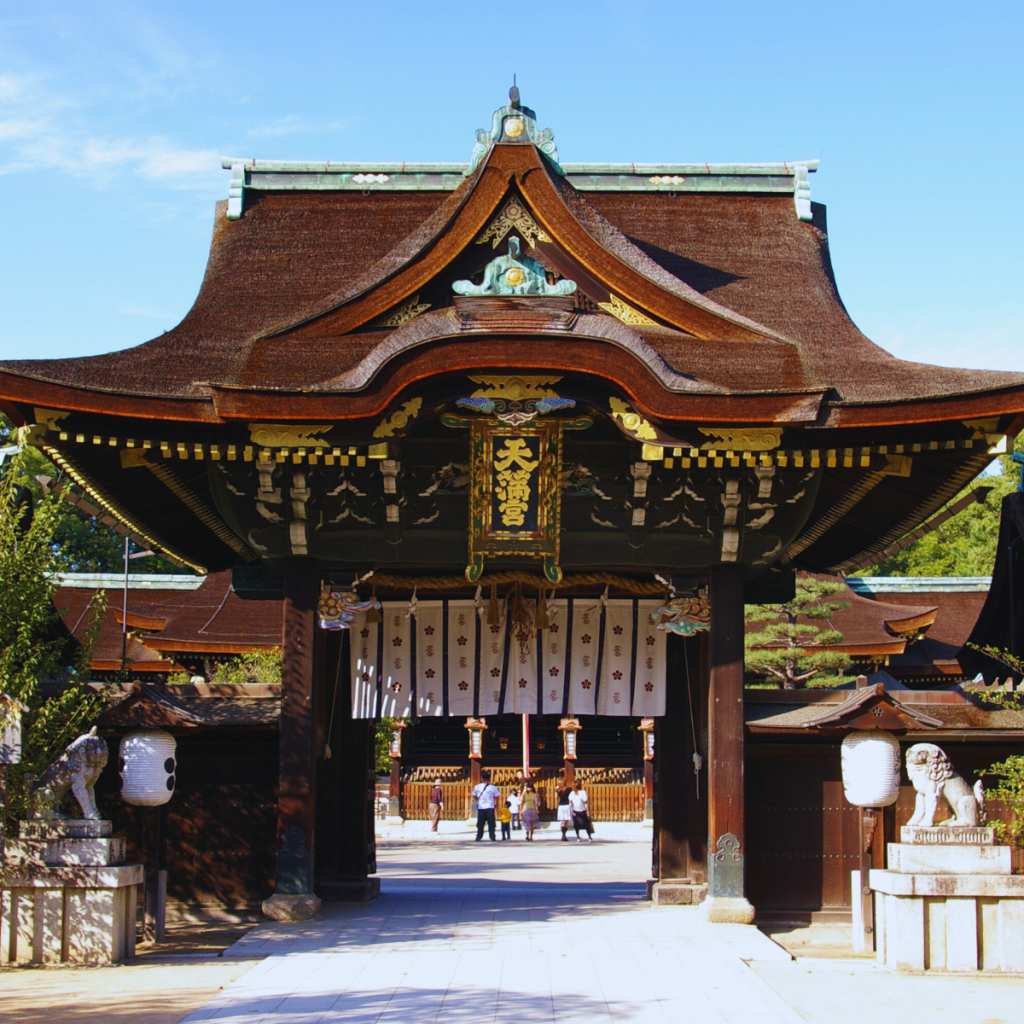
Date: October 1st-5th, 2023
Kitano Tenmangu Shrine: Origin and Significance
The Zuiki Matsuri is held at Kitano Tenmangu Shrine, established in 947 AD. The Shrine enshrines Sugawara Michizane, a renowned scholar, litterateur, and politician of the early Heian Era (845-903). Tenjin-san, as it is fondly known by locals and believers, is the headquarter of over 12,000 Tenmangu shrines across Japan. The Shrine attracts numerous visitors throughout the year with various seasonal highlights such as Ume tree blossoms, vibrant maple leaves, and the famous autumn harvest festival.
Rituals and Processions: Celebrating Autumn Harvest
Zuiki Matsuri celebrates the bountiful autumn harvest by featuring unique Mikoshi (portable shrines) made of taro stems called Zuiki. The festival begins with a divine Shinto ritual and follows with three Horen (imperial carriages) and Matsu-hoko (long-handled spears) parading around the shrine premises. This parade includes more than 350 priests and shrine parishioners marching to express gratitude for their fruitful crops.
Zuiki Mikoshi: A Taro Stem Marvel
A central attraction of the festival is the Zuiki Mikoshi, a one-of-a-kind portable shrine adorned with taro stems and dried vegetables. The tradition of decorating Mikoshi dates back to Kitano Matsuri Festival (Reisai Festival), where people would decorate them using vegetables offered at the altar. The roof of the Zuiki Mikoshi is crafted from taro stems, while other parts showcase crops and dried goods like green vegetables, Yuba (dried bean curd), and wheat bran. This unique work of art can be admired at Otabisho between October 1st and 4th.
Traditional Dance: The Elegance of Yaotomemai
On the first and last days of Zuiki Matsuri, primary school girls selected from the shrine area perform a graceful traditional dance called Yaotomemai. Dressed in exquisite costumes, they offer this dance with bells in Haiden, the Shrine’s main hall. Visitors are advised not to bring or consume food within the premises, as it is considered disrespectful. Additionally, entering the main Shrine called Honden is prohibited.
Geiko and Maiko Splendor: A Colorful Finale
The five-day celebration of Zuiki Matsuri harks back to its thousand-year-old history that began in the mid-900s as a procession honoring Kitano Tenmangū deity for bountiful harvests. The grand festival procession departs from Kitano Tenmangū on the first day with several Omikoshi (portable shrines). After going around neighborhoods, it arrives at a temporary shrine where rituals are held, such as the Yaotome Dance performed by young girls.
Following a three-day interval, another procession moves the portable shrines back to Kitano Tenmangū with ox-drawn carts. The final day witnesses a concluding dance offering amid great revelry. Geiko and Maiko from the Kamishichiken district can be seen attending both processions in their splendid attire.
With an iconic autumn festival like Zuiki Matsuri showcasing legendary scenes and creatures through art panels made of vegetables, along with strings of colorful dried scarlet eggplants, citrus, and peppers adorning each corner of the Omikoshi — it’s no wonder that this event stands out as one of Kyoto’s most cherished celebrations.
Kotobuki-kai
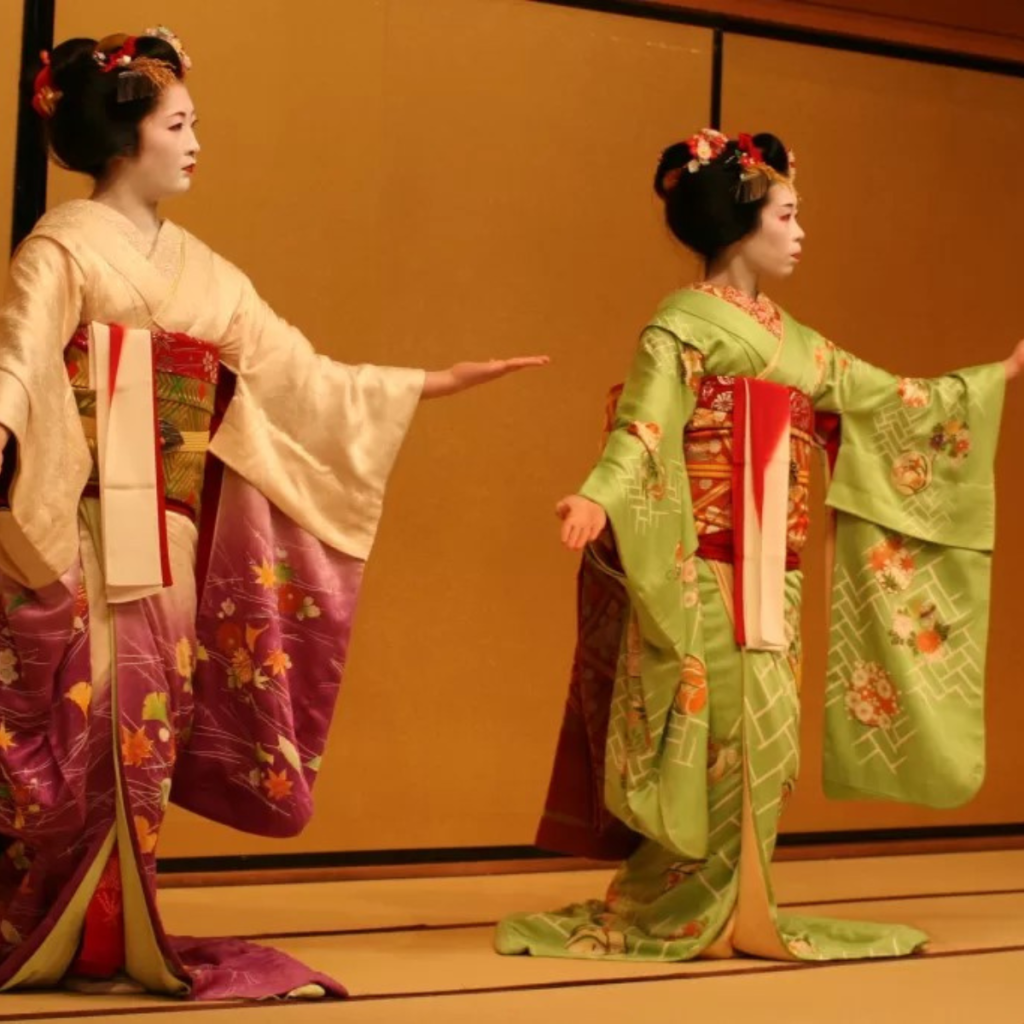
Date: October 6th – 8th, 2023
Kamishichiken District’s Exclusive Kotobuki-kai Performance: A Chance to Enjoy Geiko and Maiko Dances in Autumn
Kyoto, Japan, is known for its well-preserved tradition and culture, with geiko and maiko (apprentice geiko) being among the most iconic symbols representing the ancient capital. While many visitors may be aware of the large-scale performances held by the five geisha districts in spring, a lesser-known but equally captivating event occurs each year during autumn: the Kotobuki-kai performance.
An Intimate Cultural Experience in Kyoto
Held at Kamishichiken, one of Kyoto’s oldest geisha districts, the annual Kotobuki-kai performance offers an opportunity to witness mesmerizing dance numbers by expert geiko and their maiko apprentices. Scheduled for early October every year, this exclusive event is distinct from its more famous counterpart held during cherry blossom season.
The origin of the Kotobuki-kai performance dates back to the mid-1800s when each district was ordered by the Tokugawa shogunate to form official groups called “nakama.” Kamishichiken’s nakama was named “Kotobuki Nakama,” highlighting its connection with prosperity and longevity since “kotobuki” is related to congratulatory expressions.
A Showcase of Traditional Japanese Art Forms
The program consists of various dances performed separately, each showcasing unique aspects of traditional Japanese performing arts. For instance, in 2018, attendees were treated to a nagauta dance by maiko apprentices, followed by a performance by geiko. Additionally, there were folk songs and a dance set to tokiwazu music—a narrative style frequently used in kabuki theater.
The diverse representation of songs and dances featured in Kotobuki-kai offers a comprehensive look into Kamishichiken’s array of artistic talents.
A Chance for Off-season Culture Enthusiasts
While tickets for the Kotobuki-kai performance are priced marginally higher—8,000 yen per person—compared to the regular spring events, it’s an invaluable opportunity for those visiting Kyoto outside of cherry blossom season. With limited seating capacity, this performance is considered more exclusive and intimate than its more well-known counterpart, the Miyako Odori.
If you find yourself in Kyoto in early October and are passionate about experiencing authentic traditional arts up close, don’t miss out on the compelling Kotobuki-kai performance. It’s sure to offer a unique encounter with geiko and maiko while immersing yourself in an impressive showcase of Japan’s cultural heritage.
Ningyō Kuyō

Date: October 14th, 2023
Hōkyō-ji, “The Doll Temple,” Honors Centuries of History
Kyoto’s famed Hōkyō-ji temple, affectionately called “the Doll Temple,” has had a long-standing tradition of imperial princesses serving as their head priestesses. This nunnery has cared for dolls gifted from emperor fathers to their daughters, often to commemorate seasonal changes or special events. Many of these dolls have been well-preserved at Hōkyō-ji over the years.
A Glimpse into Ancient Japanese Beliefs with Tsukumogami
Japanese folklore includes belief in tsukumogami, a spirit class that is believed to form when an item reaches its one-hundredth year. Human-shaped items are believed to be susceptible to becoming tsukumogami, and some people believe these objects contain a “soul.”
Kyoto Doll Commerce & Industry Cooperative Supports Ningyō Kuyō Ceremony
In partnership with the Kyoto Doll Commerce & Industry Cooperative, Hōkyō-ji conducts the annual Ningyō Kuyō ceremony. This event soothes the spirits of well-loved dolls deemed no longer needed or worn. The ritual sends off the dolls respectfully, rather than being discarded as trash.
October 14th Marks the Annual Spiritual Journey for Kyoto’s Dolls
This unique ceremony takes place on October 14th. The nuns of Hōkyō-ji gather before the Doll Burial Mound, where ashes of previously-conducted ceremonies’ dolls are entombed.
A Blend of Culture and Tradition: Tayū and Imperial Princess Roles
Participants include a woman dressed as a tayū, an archaic title for Japanese women of high social rank, who presides over the event. Additionally, two women dressed in traditional imperial princess attire accompany her.
Prayers, Incense, and Flowers: Paying Respects to Doll Spirits
Throughout the ceremony, attendees witness prayers, incense, and flowers offered to the Doll Burial Mound. Following this poignant display of gratitude and respect, the nuns commence with a Buddhist service. The event concludes with a tayū-style song and dance performance that evokes feelings of reverence for the dolls’ journey.
Finding a Reverent Farewell: Kyoto’s Doll Memorial Services
If you find yourself in possession of a well-loved doll nearing its end, consider attending a doll memorial service at Kyoto’s Hōkyō-ji temple. The Ningyō Kuyō ceremony offers an elegant and meaningful send-off for cherished companions from days gone by.
Awata Taisai
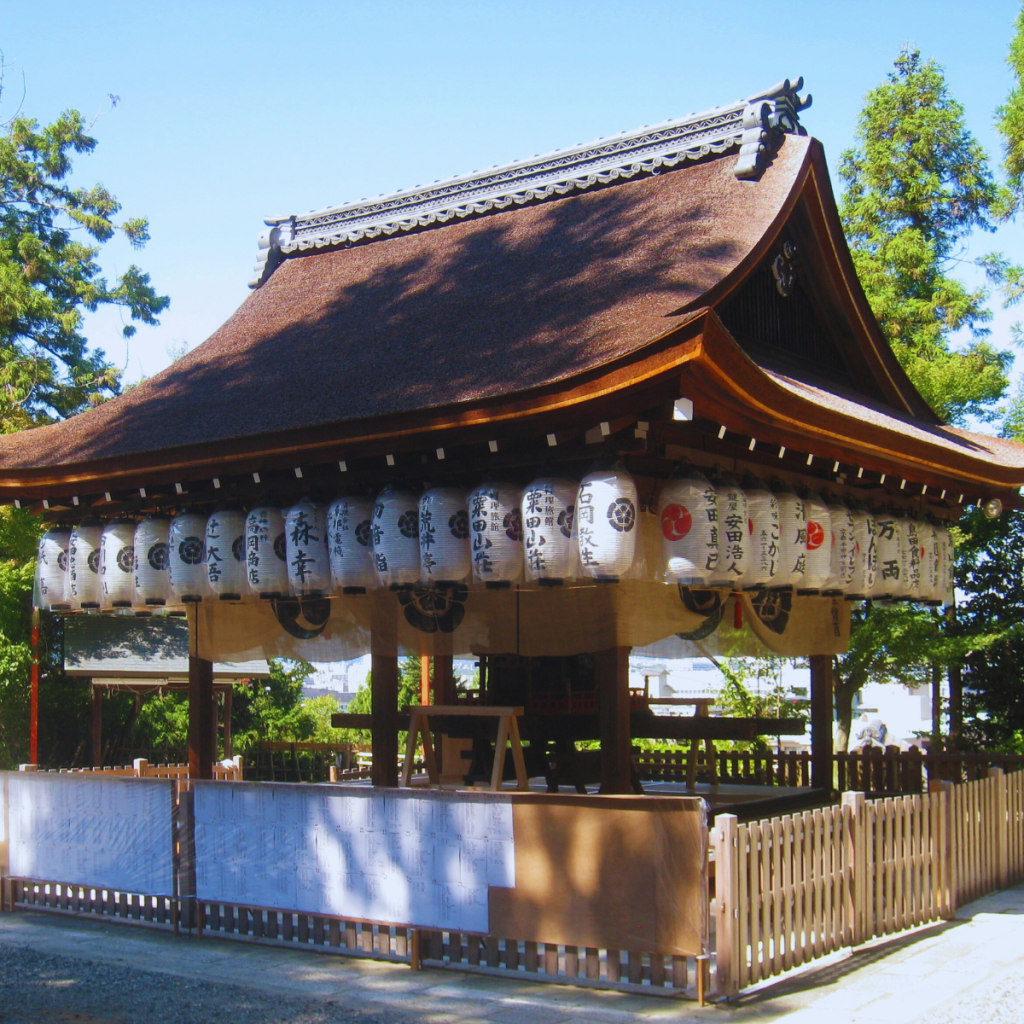
Date: October 15th, 2023
Awata Shrine: Ancient and Revered Location in Kyoto
Located in the south part of Kyoto, the Awata Shrine is a revered site that dates back to the Heian Era (794 – 1185). The shrine is dedicated to deities Susanowonomikoto and Oonamuchinomikoto and has been historically honored by locals as a symbol of divine protection. The most significant event held at the shrine is the annual Awata Festival or Awata Taisai, which comprises five Shinto rituals and events.
Awata Festival: Rich Traditions and Vibrant Celebrations
The festival begins with the Oide Festival, followed by Yowatari Shinji Shinto ritual on the next day. The procession of “Awata huge lanterns (Awata daitourou)” adds a distinct visual appeal to this event. These intricately crafted lanterns are often created by university students in Kyoto, who draw inspiration from myths and oral traditions.
As part of the Yowatari Shinji event, Shinto priests and monks welcome the divine spirit by circling around a sacred stone called “Uryuseki” three times. This ritual is a gesture of gratitude towards the god of Awata descending upon them.
Reiken Ceremony: A Rare Collaboration between Shinto Priests and Buddhist Monks
The Reiken ceremony involves parading large lanterns made up of traditional Japanese paper painted with images of mythological creatures and deities. The lanterns are assembled for a stately procession through the Higashiyama area, heading down to Chion-in temple. During this rare ceremony, Shinto priests join Buddhist monks in paying their respects to Uryūseki, reiterating the unity between these two spiritual practices.
Shinkosai Festival: Exciting Parade of Long-Handled Spears and Portable Shrines
The climax of the Awata Festival is the Shinkosai Festival, which aims to energize the shrine parishioners by parading around the area. Over 200 people carry a massive Mikoshi (portable shrine) while others hold Kenhoko, long-handled sacred spears that weigh between 40 – 60 kilograms and are 7 – 8 meters tall. The skills and balance demonstrated during this parade leave spectators in awe.
The procession also includes eighteen kenboko or ceremonial polearms, each with a unique design. These sacred artifacts are known to chase away evil spirits and are an integral part of the Shinkō-sai procession.
With that said, Awata Taisai is an annual event that offers not only an immersive experience in traditional Japanese spiritual practices but also showcases vibrant rituals and vivid imagery. For those visiting Kyoto in October, this unique series of events at Awata Shrine is undoubtedly worth witnessing.
Kasagake Shinji
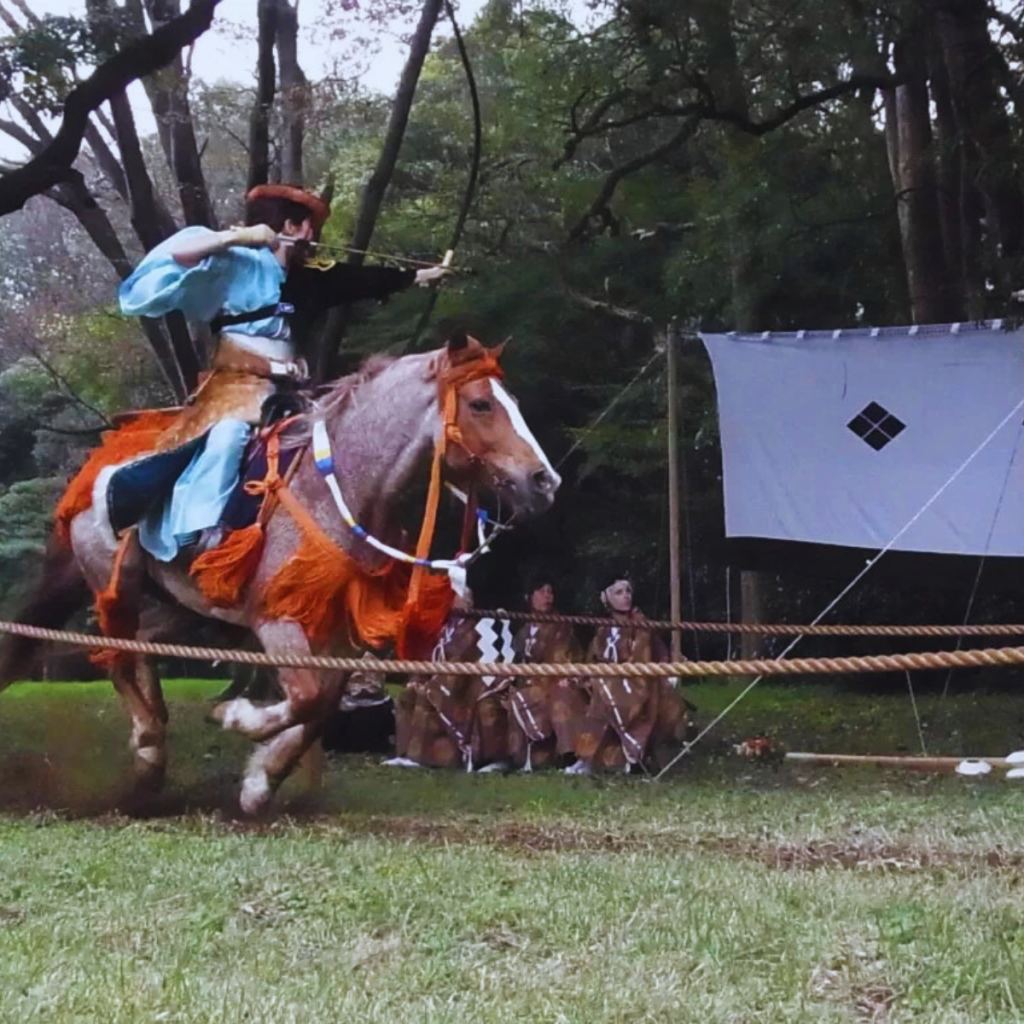
Date: October 15th, 2023
Deities Entertained with Historical Kasagake Shinji Performance
The Kamigamo Shrine recently hosted the traditional Kasagake Shinji, a mounted archery event that showcases one of Japan’s three original styles of archery. This style of archery is performed to entertain shrine deities, and the event took place in October at the sacred Kamigamo Shrine.
A Recreating Historical Practice Drills
The Kasagake Archery performance refers to the practice drills performed by archers during Japan’s warring period. This historical event has been recreated as part of a religious offering, and the skilled participants are from the renowned Takeda-ryū school of mounted archery.
Comparing Kasagake Archery to Other Styles
In contrast to the more commonly performed yabusame ritual, where archers shoot at a single fixed target, participants in the Kasagake Shinji aim at five different targets. These include three shoulder-height targets and two closer to the ground, simulating realistic military maneuvers experienced on historic battlefields.
Scoring and Competition
Each participant’s score is announced after each run, and those with the highest scores advance to the second round. During this round, target sizes are reduced as competition intensifies until an ultimate winner is crowned.
Exhilarating Horse Riding Display at Kamigamo Shrine
Spectators express exhilaration when watching riders race down trails while drawing back their arrows before skillfully releasing them toward their intended targets.
Event Time and English Commentary
Starting from 12:30, the main archery portion of this spectacular event begins at 13:00. The Kamigamo Shrine ensured that even non-Japanese speaking visitors could fully appreciate and understand the event’s history and significance by providing English commentary from one of their informative priests.
Marveling at the Beauty of Horses and Riders
The Kasagake Shinji performance at Kamigamo Shrine invites spectators from all around the world to witness the beauty of both horses and riders. This event pays homage to Japan’s traditional archery roots while showcasing the skilled prowess of modern archers.
Saigū Gyōretsu
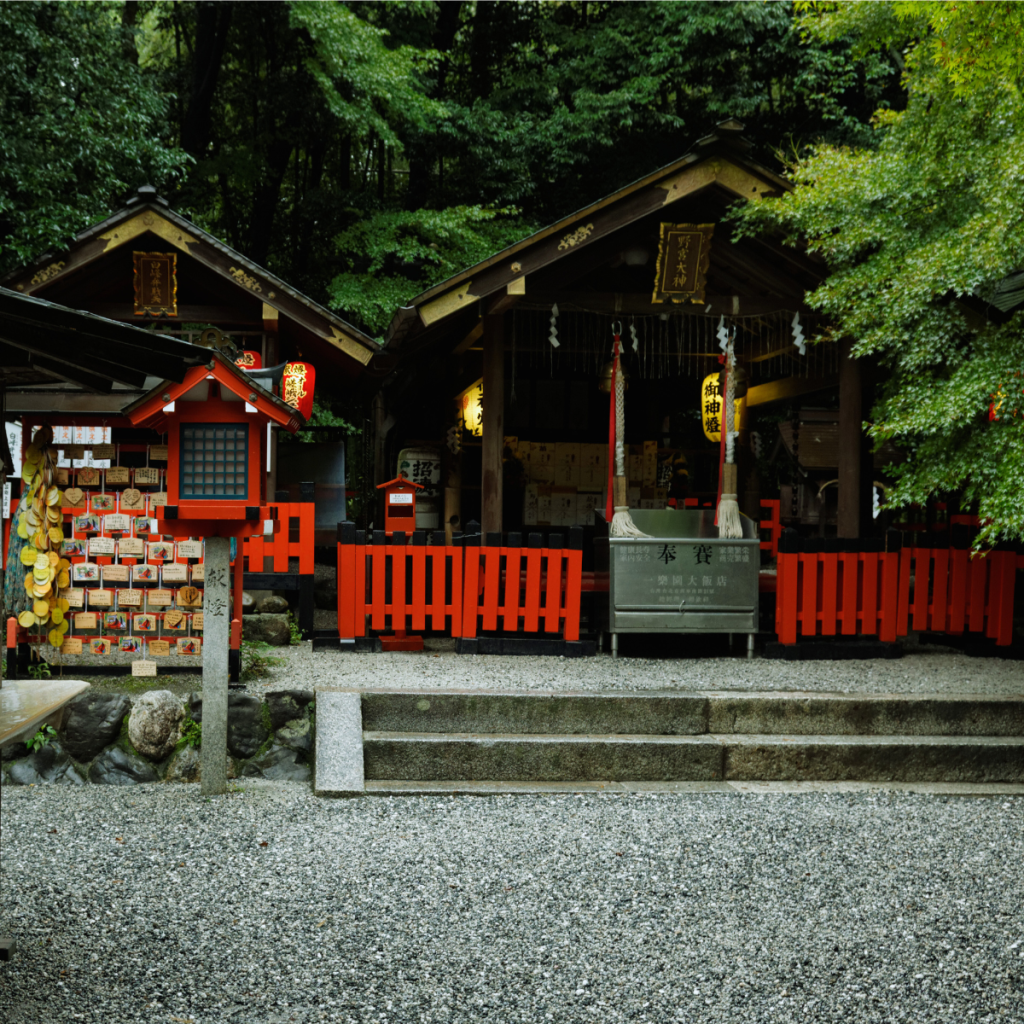
Date: October 15th, 2023
The annual Saigū Gyōretsu procession, held at the Nonomiya Shrine in Arashiyama, Kyoto, is a beautiful reenactment of an ancient tradition celebrating saigū, priestesses from the imperial family who were appointed as emissaries to the grand shrine at Ise. Visitors can enjoy a colorful recreation of history, where women dress in elegant Heian period costumes and court regalia.
Reenacting an Ancient Tradition – From Purification Rituals to Priestess Departure
The Saigū Gyōretsu procession commemorates the purification rituals that once took place at Nonomiya Shrine before saigū embarked on their journey to serve as emissary priestesses at Ise Shrine. The grand shrine at Ise is dedicated to the sun goddess Amaterasu, who is believed to be the progenitor of the imperial lineage.
The event takes place each year in October and sees a procession move from the Nonomiya Shrine down to the river, where these purification rituals are performed. The woman representing the saigū is escorted by other women adorned in identical noble attire and Heian period clothing worn by attendants and handmaidens.
A Journey through History – Priestesses, Priests, Soldiers, and Servants
Not only women partake in this historical reenactment; priests also accompany the procession along with men dressed as soldiers and servants of that era. Performers entertain visitors throughout the event, providing a unique glimpse into the ancient Heian Period of Japan’s past.
Omisogi no Gi Ceremony – Releasing Paper Dolls for Purification
As part of the Saigū Gyōretsu procession, a purification ceremony called Omisogi no Gi occurs at the riverbank. In this ritual, priestesses perform a beautiful dance while a priest offers prayers to Ise Shrine. The saigū then approaches the water’s edge and releases a paper doll symbolizing purification.
Celebrating with Traditional Court Music and Dance
The Saigū Gyōretsu procession concludes with visitors joining the prayers towards Ise Shrine while enjoying traditional court music known as gagaku and dance called bugaku. These performances serve as a final offering in this historical reenactment journey back in time to Japan’s Heian Period.
To make your visit to Arashiyama even more memorable, plan your trip to coincide with this historical event that transports you straight into the heart of the Heian Period – the Saigū Gyōretsu procession.
Twenty-Five Bodhisattvas Procession Service
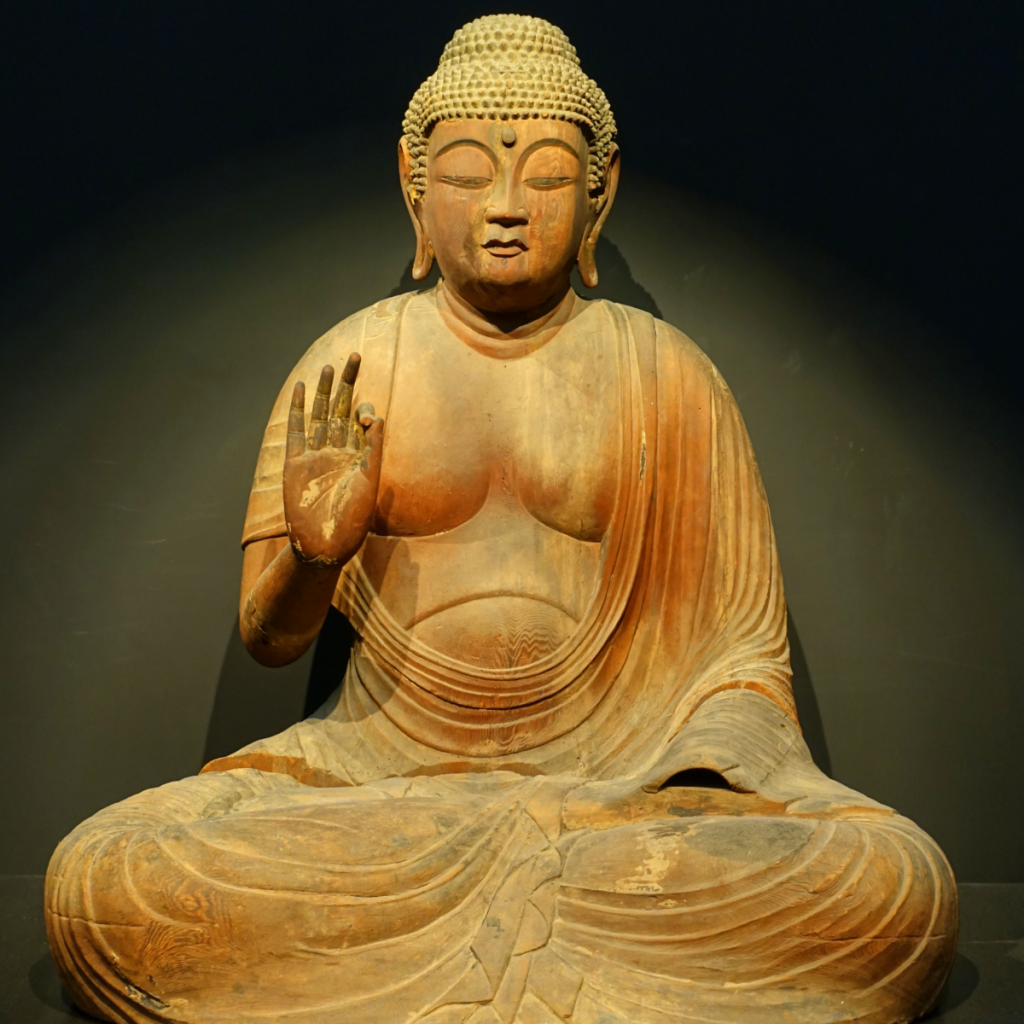
Date: October 15th, 2023
Sacred Ritual Honoring Amida Buddha and Bodhisattvas
A unique and sacred Buddhist ceremony unfolds at Japan’s Sokujō-in temple. Known as the Nijūgo Bosatsu Oneri Kuyō, or Twenty-Five Bodhisattvas Procession Service, this ceremonial event brings to life the ancient tradition of Pure Land Buddhism. It honors Amida Buddha, who bestows salvation and rebirth in the Pure Land for those who seek refuge in his compassion by uttering “Namu Amida Butsu” (I take refuge in the compassion of Amida Buddha).
Celebrating a Millennia-Old Spiritual Journey
The Nijūgo Bosatsu Oneri Kuyō ritual involves 25 participants donning special helmet-like masks, golden halos, and brocade clothing to transform themselves into holy bodhisattvas. These spiritual beings then embark on a pilgrimage on a raised bridge built specifically for the occasion, connecting two halls within Sokujō-in temple’s grounds.
This annual ceremony symbolizes Amida Buddha’s sacred journey, along with his retinue of bodhisattvas descending on clouds to guide the dying towards salvation. Taking place at Sokujō-in — a sub-temple of the larger Senyū-ji temple complex — this procession exhibits not only rich cultural aesthetics but also deep spiritual significance.
An Unparalleled Theatrical Spectacle
The ceremony commences in the temple’s main hall before an audience comprised of statues representing Amida Buddha and the 25 bodhisattvas. These statues hold great value as certified Important Cultural Properties of Japan. Dignified priests from Sennyū-ji — Sokujō-in’s head temple — lead the first procession, accompanied by yamabushi mountain ascetics and gagaku musicians.
Young children serve as chigo (sacred pages), offering their contributions in the presence of beaming kimono-clad parents. After presenting their offerings at the altar in the Jizō-dō hall, they return to scatter paper “petals” (believed to bring good fortune) from golden platters, as visitors eagerly extend their hands to receive them.
The Main Act: Bodhisattvas in Action
In the third part of the ceremony, masked “bodhisattvas” make their grand entrance, led by Jizō Bosatsu in a bright orange outfit and a more human-like mask. With 25 bodhisattvas performing dances and playing instruments atop the bridge, it feels as if Amida’s heavenly host is actually traversing between the Pure Land (main hall) and our mortal world (Jizō-dō hall).
Once all bodhisattvas have returned to the main hall, a treasure pagoda is unveiled from a special palanquin and placed on a platform at the center of the space. This marks the commencement of another votive performance known as The Dance of the Pure Land, which is performed around the pagoda by Kannon Bosatsu, Seishi Bosatsu, and Fugen Bosatsu. Following these enchanting dances, participants offer their final prayers before the altar, signaling the conclusion of this time-honored event.
A Cultural Treasure Unlike Any Other
With a history spanning over a thousand years and very few temples across Japan partaking in similar rituals, Sokujō-in’s Nijūgo Bosatsu Oneri Kuyō is truly an unforgettable experience. This annual ceremony seamlessly marries ancient tradition with captivating spectacle that ultimately reminds visitors of its sacred purpose: celebrating Amida Buddha and the compassionate work of the heavenly bodhisattvas.
Funaoka Taisai
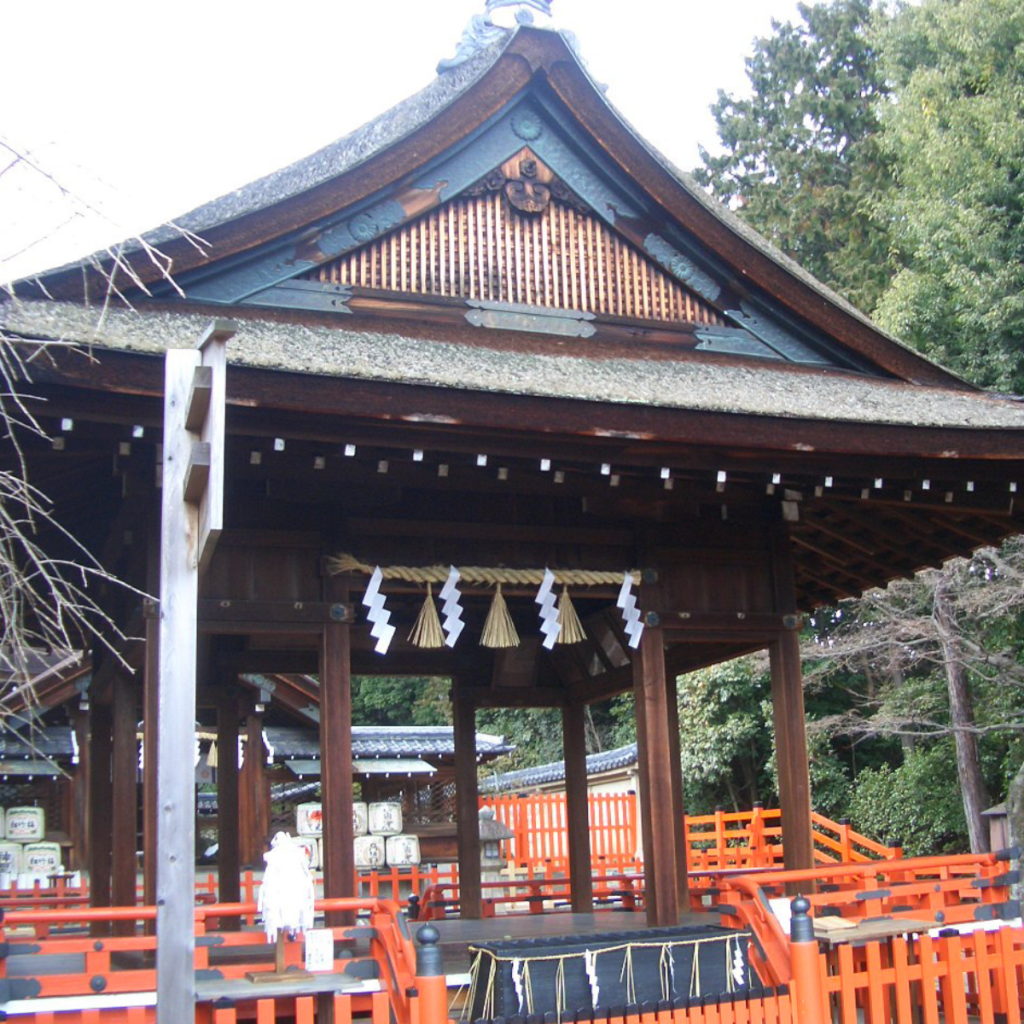
Date: October 19th, 2023
Annual Ritual at Kenkun Shrine
The Funaoka Taisai, also known as the “Funaoka Grand Festival,” is an annual ritual held at Kenkun Shrine located on Mt. Funaoka in northwestern Kyoto. This event takes place on October 19th each year, commemorating the famous 16th-century warlord, Oda Nobunaga’s entry to the ancient capital of Kyoto in 1568.
Oda Nobunaga is deified in Kenkun Shrine and is remembered as a key unifying figure in Japanese history. He played a significant role in ending the period of unrest during the latter half of the Muromachi Period. His rule paved the way for Japan’s eventual modernization, as he successfully united various independent fiefdoms under his banner before his death in 1582 during an insurrection.
Festival Origins and Purpose
The Funaoka Taisai was conceived to extol Oda Nobunaga’s accomplishments, recognize his contributions to Japan, and inform future generations about his legacy. The festival features offerings of food and drink to the enshrined warrior alongside prayers led by shrine priests. Visitors are invited to join the priests in showing reverence towards Nobunaga’s spirit.
Visiting Kenkun Shrine and Exploring its Surroundings
Kenkun Shrine, situated on a small hill, offers visitors stunning views of Mt. Hiei and Mt. Daimonji. It is home to several Important Cultural Assets, including the Yoshimoto Samonji sword and the Shincho Koki – a biography of Oda Nobunaga.
Funaoka Taisai as an Opportunity to Experience Japanese Culture
The Funaoka Taisai is an excellent opportunity for visitors to Kyoto in October to experience local culture while remembering a pivotal figure in Japanese history. By attending this event, you can enjoy traditional performances and learn more about Oda Nobunaga’s enduring legacy.
Kiyomizuyaki no Sato Matsuri
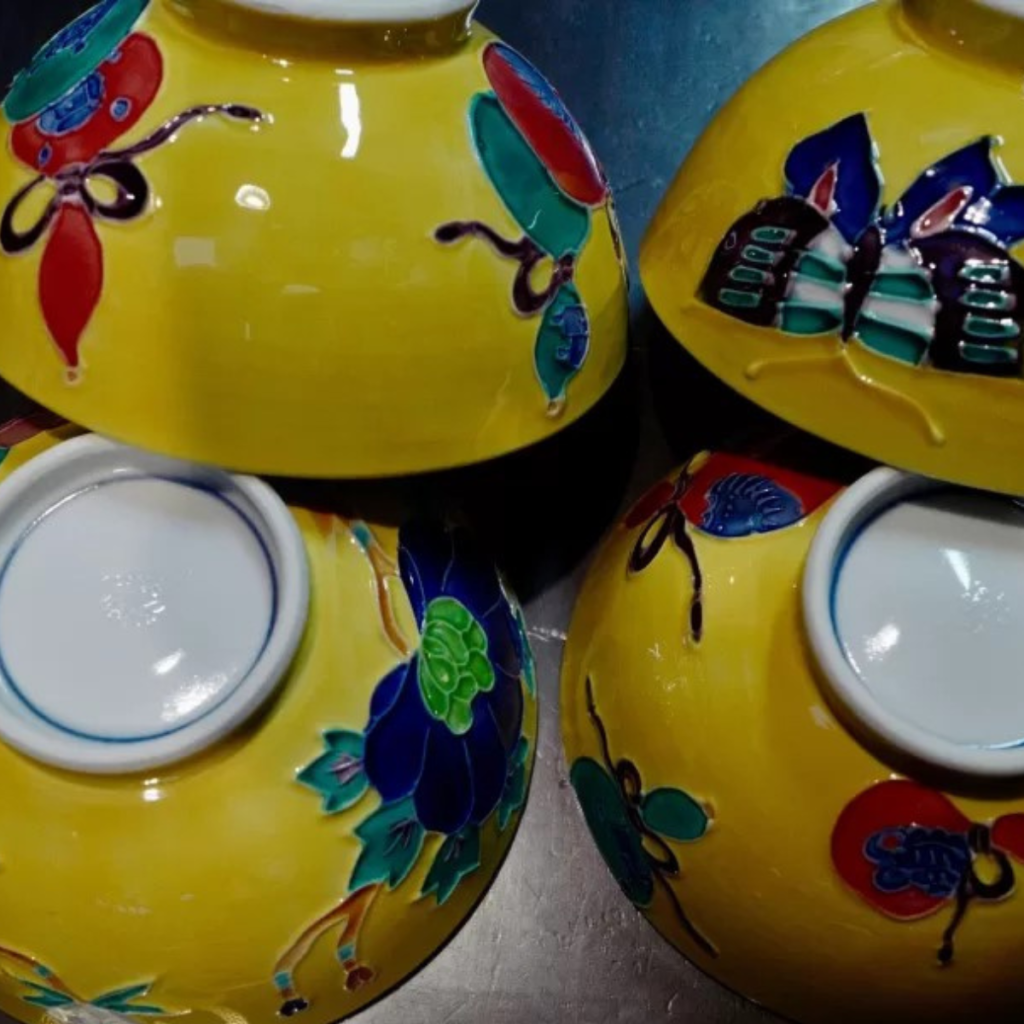
Date: October 20th – 22nd, 2023
Showcasing Local and National Kyoto Ware
Every October, Kiyomizuyaki no Sato Matsuri, a large pottery festival in Kyoto, brings together local and national artisans to showcase their exquisite craftsmanship. Centered around the famous Kyoto ware (Kyō-yaki/Kiyomizu-yaki), this event occurs on the third Friday, Saturday, and Sunday of the month, providing attendees an opportunity to browse through dozens of shops and stalls. From unique ceramics to one-of-a-kind souvenirs, this annual gathering welcomes both pottery enthusiasts and casual visitors alike.
Hands-on Experiences and Entertainment
Beyond admiring and purchasing expertly crafted pottery, attendees can also engage in hands-on experiences like making their own clay figurines or trying their hand at creating traditional tea bowls on a potter’s wheel. Children are also encouraged to play with clay while parents can recharge with local cuisine such as zenzai red bean soup or coffee. Live performances further enliven the festive atmosphere.
Rich History Behind Kiyomizuyaki-danchi
The festival takes place in Kiyomizuyaki-danchi – an area renowned for its concentration of pottery makers, clay suppliers, wholesale traders, artists as well as woodworkers and doll-makers who historically resided on Gojō-zaka and Kiyomizu-zaka streets around the Kiyomizu-dera temple. This neighborhood’s name is derived from its deep connection to pottery.
Traditionally, Kyoto potters prioritized producing high-quality pieces that catered to specific customer preferences. The rise in tea ceremony popularity during the Momoyama period inspired a significant expansion in the pottery industry. Kyō-yaki craft began with locally replicating Chinese and Korean ware before branching into adopting techniques from across Japan. It later gained prominence as a form of decor, necessitating the development of unique designs and advanced production methods.
Artistic Fusion Characteristic of Kiyomizuyaki
One notable aspect of Kyō-yaki/Kiyomizu-yaki is its intrinsic fusion of various art forms. Festival-goers can discover pottery pieces that borrow elements from the Rinpa school of art, Nishijin-ori weaving, yuzen-zome dyeing, Itō Jakuchū paintings, maki-e lacquerware, and several other influences like the venerable pottery masters Nonomura Ninsei and Okuda Eisen. This harmonious blending not only preserves traditional culture but adapts to contemporary demands as well.
Lightening the Flame of Kyoto Pottery Tradition
Today’s Kyoto pottery makers ensure their work caters to various tastes while expressing their artistic passion. Visitors to Kiyomizuyaki no Sato Matsuri can expect to find Masters of Traditional Crafts alongside young artisans showcasing their products. From thoughtful gifts and chic art objects to functional dishware and elegant flower vases – an irresistible array of beautiful ceramics awaits at this vibrant festival celebrating Kyoto pottery.
Jidai Matsuri
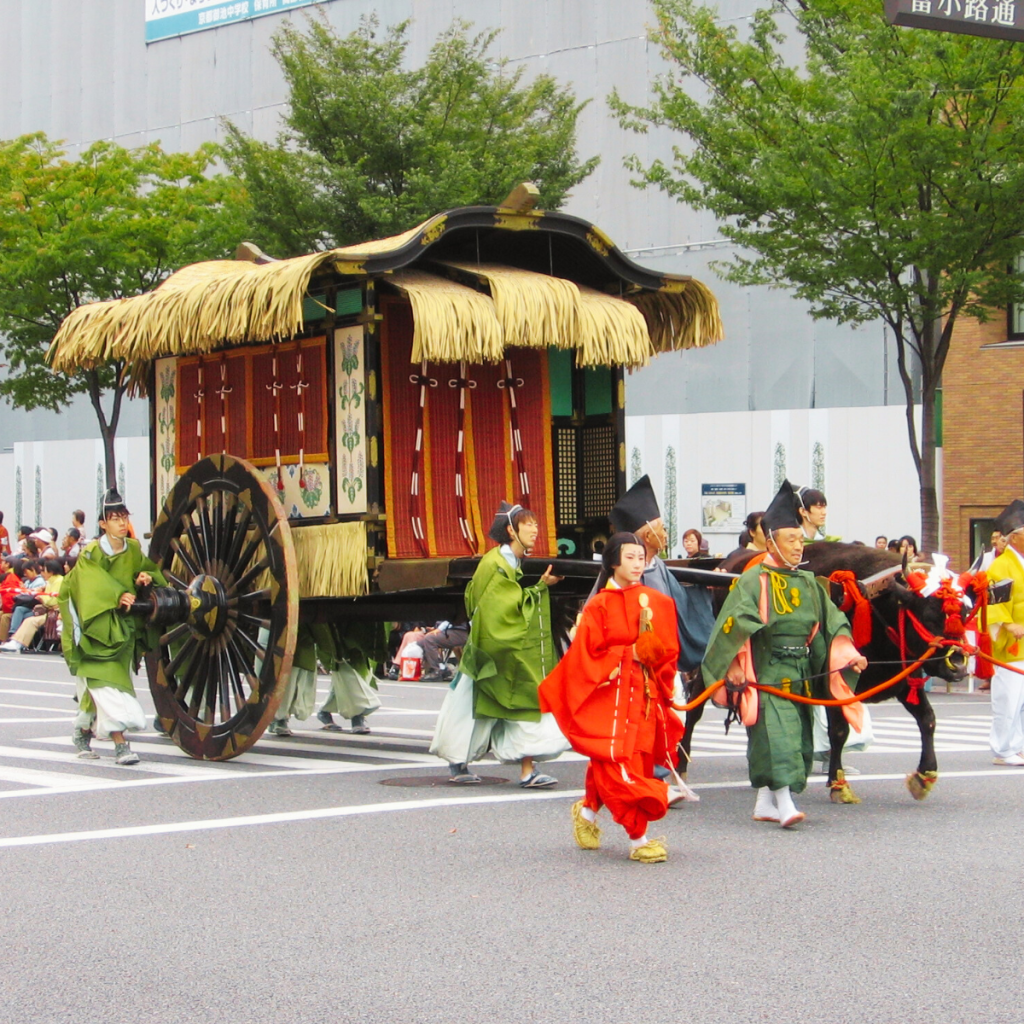
Date: October 22nd, 2023
Offering a chance for viewers to witness a walking history exhibition, Jidai Matsuri remains one of Kyoto’s top festivals despite being a relatively new tradition. Mark your calendar for October 22nd each year and prepare yourself for an unforgettable journey into Japan’s rich cultural past.
The Festival of Ages: An Overview
Held annually on the 22nd of October, Jidai Matsuri, or the Festival of Ages, is one of the most significant cultural events in Kyoto, Japan. It was introduced in 1895 to commemorate the movement of Japan’s imperial capital from Nara to Kyoto in 794. The festival provides a unique opportunity for visitors to learn about Japanese history, as it encompasses a grand parade showcasing various aspects of Japan’s cultural past.
The procession features hundreds of volunteers dressed in meticulously recreated historical garb, representing Japanese cultural history from the ancient Enryaku era (782-806) through the Meiji era (1868-1912). Every year, two hanamachi (geisha districts) participate in the parade on a rotational basis; in 2015, it was Pontocho and Gion Higashi’s turn.
Japanese historical figures like Tomoe Gozen, a famous female samurai who is always played by a Geiko (skilled artist), take center stage during the parade. In 2015, she was portrayed by Ichisayo of Daiichi Okiya from Pontocho.
The Procession: Traveling Through Japanese Eras
Jidai Matsuri is part of Kyoto’s “Three Great Festivals,” and its vibrant procession constitutes its centerpiece. Beginning with the Meiji era and traveling back to the Heian period (794-1185), participants are carefully arranged in chronological order to celebrate Japan’s rich history.
Famous historical figures like Murasaki Shikibu, author of The Tale of Genji, and successful Samurai Oda Nobunaga are also depicted during this grand event. The whole spectacle gives an authentic flavor of Japan’s past while highlighting its customs and centuries-old traditions.
Highlight: Authentic Historical Costumes
Part of what sets the Jidai Matsuri apart from other festivals is its commitment to historical accuracy. The costumes, makeup, and hairstyles featured in the procession are all closely based on documented evidence from the periods they represent.
The festival’s costumes are crafted by an organization called “Dento Fukushoku Kogei Kyodo Kumiai,” which comprises established clothing stores working together to recreate these phenomenal outfits using traditional Kyoto techniques. Some costume pieces can cost tens of millions of yen due to their faithful reproduction of ancient methods and materials.
Kurama no Hi Matsuri
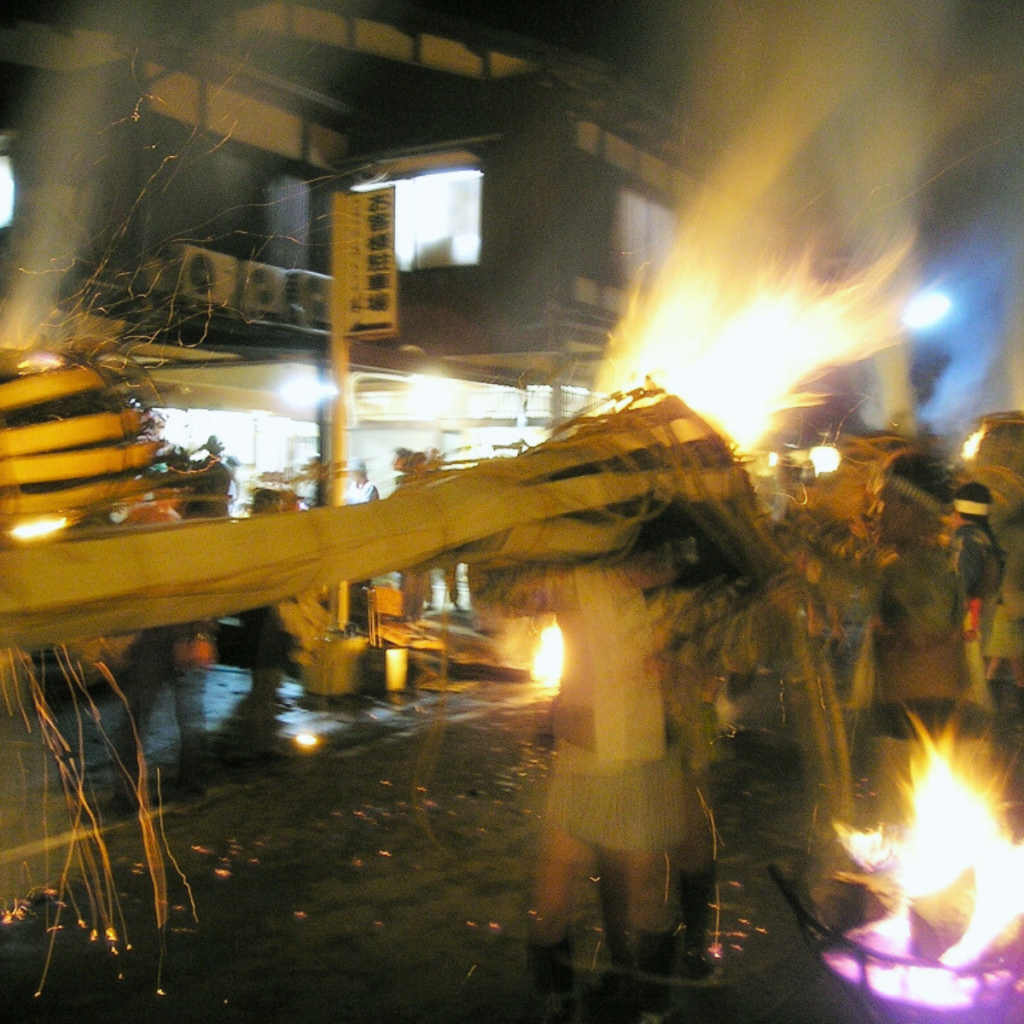
Date: October 22nd, 2023
A millennia-old tradition steeped in history and culture
The Kurama Fire Festival, also known as Kurama no Hi Matsuri, has its roots in a rich tapestry of Japanese history, dating back over 1,000 years. Held annually in the town of Kurama, located just 30 minutes by train from Demachiyanagi Station in Kyoto, this captivating event offers an unforgettable cultural experience like no other.
The festival is a traditional shinto ritual held at the Yuki-jinja Shrine every October and plays an integral part in Kyoto’s Three Eccentric Festivals. With its origins traced back to ominous times when significant earthquakes and conflicts were rampant, Emperor Daigo had the shrine relocated from Heian-Kyo (ancient Kyoto) to Kurama as a means to alleviate public unrest. The awe-inspiring sight of enormous flaming torches being carried during the ritual has captivated residents and visitors for centuries.
Taimatsu: Flaming Torches and Sacred Ropes
The main spectacle of the Kurama Fire Festival is undoubtedly the taimatsu or torches, which are carried by locals living around the shrine through the streets of Kurama. As night descends around 6:00 pm, onlookers hear the spoken signal “shinji ni mairasshare,” signifying that the festival has begun. Children carry small torches while adults hold significantly larger ones, some weighing up to a staggering 100 kilograms! The enthusiasm and unison among torchbearers create an electric atmosphere throughout the town.
The Journey of Yuki Daimyōjin: A Celebration in Fire
The Kurama no Hi Matsuri is a commemoration of the god Yuki Daimyōjin’s journey to the Yuki Shrine in 940 AD after a series of disasters struck Kyoto’s capital. The central attraction of the festival is the procession of local men carrying enormous flaming torches through the village streets, signaling defiance and strength.
Watchfires are lit in front of homes as the sun sets, and large taimatsu weighing up to 80 kilograms are prepared by adult men for the journey ahead. Eventually, more than a hundred torchbearers gather at Sanmon Gate’s steps, creating a visually stunning spectacle rarely seen elsewhere in Japan.
Following The Ceremony of Cutting the Sacred Rope, select men ascend Mount Kurama to bring down two portable shrines and make their way around the village streets, showcasing their strength and spirit. Participants wear traditional garb consisting of warrior’s sandals, a loincloth, a braided rope skirt, colorful armguards, and a padded cloth used for holding torches.
Embracing History: Jidai Matsuri Connection
Many tourists choose to attend another popular religious event – The Jidai Matsuri (Festival of Ages) – held on the same morning as Kurama Fire Festival. Both festivals draw huge crowds due to their significance in Japanese culture. Those wishing to experience both events should make travel arrangements as early as possible.
Celebrated annually until midnight amid warm October weather, Kurama no Hi Matsuri is a vital remnant of ancient Japanese tradition that transports participants and spectators into an era long gone, yet fervently alight with passion and history.